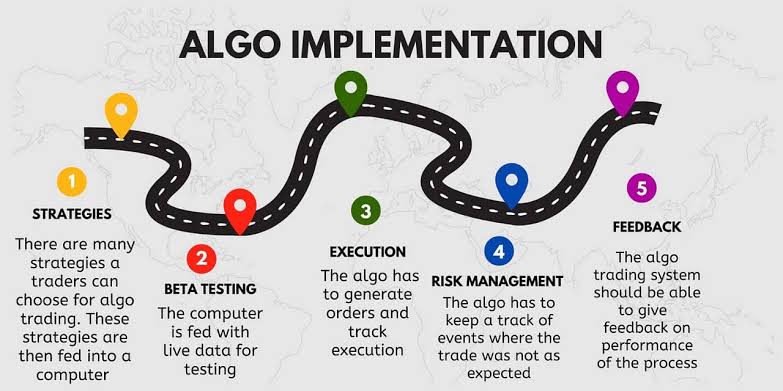Advanced Trading Strategies: Order Flow, Quant Edges, and a Practical Risk Playbook
1) Market Microstructure Snapshot
Price moves where liquidity is thin and urgency is high. Before you trade, map:
- Liquidity Pockets Prior highs/lows, session opens, round numbers.
- Book Imbalance One-sided depth often front-runs a quick sweep.
- Volatility State Use
ATR(14)and session range vs 20-day average.
2) Order Flow Momentum (OFM)
OFM rides short bursts when aggressive orders hit the book.
Rules
- Signal: 3-bar micro impulse where each bar closes in top 30% of its range and cumulative delta > 1.5× its 20-bar average.
- Filter: Spread ≤ 1.2× usual,
ATRabove its 50-day median. - Entry: Buy stop 1 tick above signal bar high. Short is the mirror.
- Stop: Below signal low (long) or above high (short).
- Exit: Scale half at 1R, trail remainder with a
Chandelier ATR(3).
Why it works: It aligns with real urgency, not just plotted indicators.
3) Volatility Breakout System
Classic range expansion with modern protections.
Setup
- Compute
NR7(narrowest range of last 7 bars) or a 20-day Donchian channel. - Confirm rising volatility: today’s true range > 1.2× 20-day median.
Entry & Management
- Entry stop at
High(NR7)+ϵfor long; short atLow(NR7)-ϵ. - Initial stop at opposite side of the NR7 bar.
- Take partial at 1.5R. Hold rest until a close back inside yesterday’s range.
4) Pairs Trading (Stat Arb Lite)
Trade relative value instead of direction.
Quick Build
- Select two correlated symbols (e.g., same sector or currency crosses with a common base).
- Compute the spread:
Spread = Price(A) - β·Price(B)whereβis from a 60-day regression. - Z-score the spread over 60 sessions.
Rules
- Enter when |Z| ≥ 2.0 against the mean. Exit at Z = 0.5.
- Stop if |Z| ≥ 3.0 or if correlation < 0.5 for 10 days.
- Dollar-neutral sizing: notional A ≈ β·notional B.
Edge comes from mean reversion in relative pricing while market direction cancels out.
5) Regime Filters
Apply a simple switch to stay aligned with the market.
- Trend filter: Trade long setups only if price >
SMA200andSMA50>SMA200. - Chop filter: If 14-day
ADX< 18, prefer mean-reversion or stand aside. - Vol filter: If 20-day ATR percentile < 30, use smaller targets or skip breakouts.
6) Execution & Slippage Control
- Use a limit-to-market ladder: place a small lead limit, then convert the rest to market only if price prints through.
- VWAP/TWAP for low urgency orders. For high urgency, accept a small slippage budget.
- Avoid thin books around news and session handovers.
- Benchmark each trade: record
fill − midin ticks and review weekly.
| Urgency | Tool | Goal |
|---|---|---|
| Low | TWAP over 20–40 mins | Blend into flow |
| Medium | VWAP slices | Match tape |
| High | Limit-then-market | Get filled near level |
7) Risk & Sizing Math
Risk a fixed fraction of equity, sized from stop distance.
Position Size
Size = (Account × Risk%) ÷ StopDistance
Example: Account 2,000; risk 0.5% (=10); stop 25 pips ⇒ size = 10/25 = 0.40 mini-lots.
Portfolio Rules
- Max open risk: 2% of equity across all positions.
- Cut losers fast. If trade is −0.5R with no improvement, consider exit.
- After two consecutive full-R losses, reduce risk by 50% until back to equity highs.
8) Daily Playbook Checklist
- Mark HTF levels, sessions, and news windows.
- Classify regime with trend, ADX, and ATR percentile.
- Pick tactics: OFM or Breakout for high vol; Pairs for chop.
- Define entries, stops, targets in advance. Pre-write orders.
- Set risk per trade and max daily loss. Log every fill and slippage.
FAQ
Do I use fixed or trailing stops?
Start with a structure-based fixed stop. Trail only after partial profit, using ATR or swing lows/highs.
Which timeframe is best?
Signal on your working timeframe (e.g., M15/H1), confirm with higher timeframe, and manage on the signal chart.
How do I avoid overtrading?
One playbook, two setups per session, and a max of three trades unless a high-quality replay appears.





